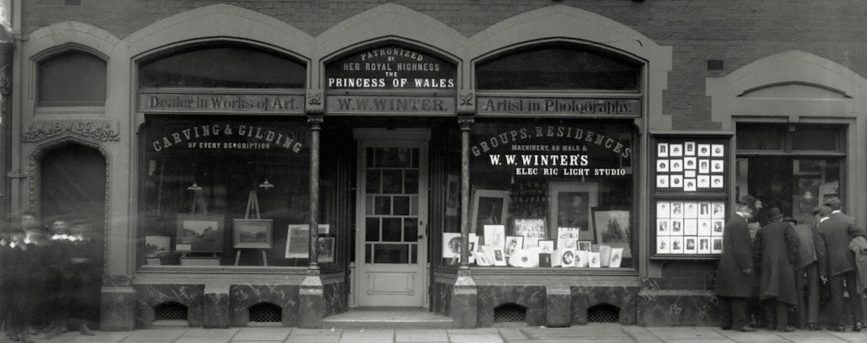Joanna has been spending some of her lockdown time delving into the history of the business. She has written two blogs:
Medal – Winter’s Fine Art Exhibitions
W.W. Winter was descended from a family of East Anglian artists. As a young man he worked alongside his artist father (also a photographer) as a painter of animals (1861 Census). It is evident from many newspaper reports that after he came to Derby and set up the Midland Road studio that the buying and selling of fine art was a major part of his business alongside photography. He also sold artists materials. Also, he had begun to exhibit his photographs and to style himself as an ‘artist in photography’.
The first exhibition aimed at encouraging art work in all of its various forms was held in 1984 and was open to amateur and professional artists. There were six exhibitions in total the last being in 1890. We have copies of the catalogues for the 1st, 2nd and 6th exhibitions and have a photocopy of the prospectus for the 3rd exhibition. The catalogues list entries in the various classes, names of judges and patrons, and names of those who donated prizes and medals. Entries could be deposited at various places around the UK for despatch to Derby. The exhibitions ran for approximately 4 weeks. Medals were silver or bronze.
The medal presented to Mrs Harold Nadin in 1886 was given at the 3rd exhibition November 2 – December 13 1886. This was opened by Lord Denman and his wife presented the prizes. The design is based on the ‘buck in the park’ which is part of the Derby coat of arms. The Danes named the town Derby which translated means ‘field of deer’. From the catalogue for the 2nd exhibition held December 2 1885 – January 26 1886 we see Mrs Nadin won a prize for painting on china. In the catalogue for the 6th exhibition May 8 – 31 1890, Mr and Mrs Harold Nadin are listed as patrons and Mr Nadin donated a silver medal.
In 1891 surplus works of art, art materials and bric-a-brac were sold off. Following building work/alterations Mr Walter Winter announced the opening of new showrooms displaying examples of Art Photographic Portraiture.
W.W. Winter – receipts and bills of sale.
The 2x bills of sale dated 1883 and 1884 were issued at the time when the sale of art materials and fine art were a major part of the Winter’s business and at the time when Winter was planning his first fine art exhibition at the studio. Interestingly they are both signed by Henry Mosley, Winter’s chief cashier at the time, who was dismissed in 1886 for irregularities in the accounts. Mosley brought a case against Mr Winter for wrongful dismissal which was reported in the Derbyshire Advertiser and Journal 13 August 1886. Mosley lost the case.
The Henry Wilmot portrait was bought by George Sutherland, a local schoolteacher and later headmaster of St Andrew’s School near the studio. The availability of these cabinet photographs was advertised in the Derby Daily Telegraph 4 June 1884 as a ‘reduced sized copy of the portrait of Sir Henry Wilmot being prepared by Mr Winter from a large one in the Derby Conservative Club’. Sir Henry Wilmot was awarded a Victoria Cross for bravery at an action in Lucknow during the Indian Mutiny. He was a local politician, alderman and honorary colonel of the local Volunteers of which Walter Winter was also a member. He also opened the 2nd Fine Art exhibition at the studio in December 1885 and donated prize medals at that and subsequent exhibitions.
